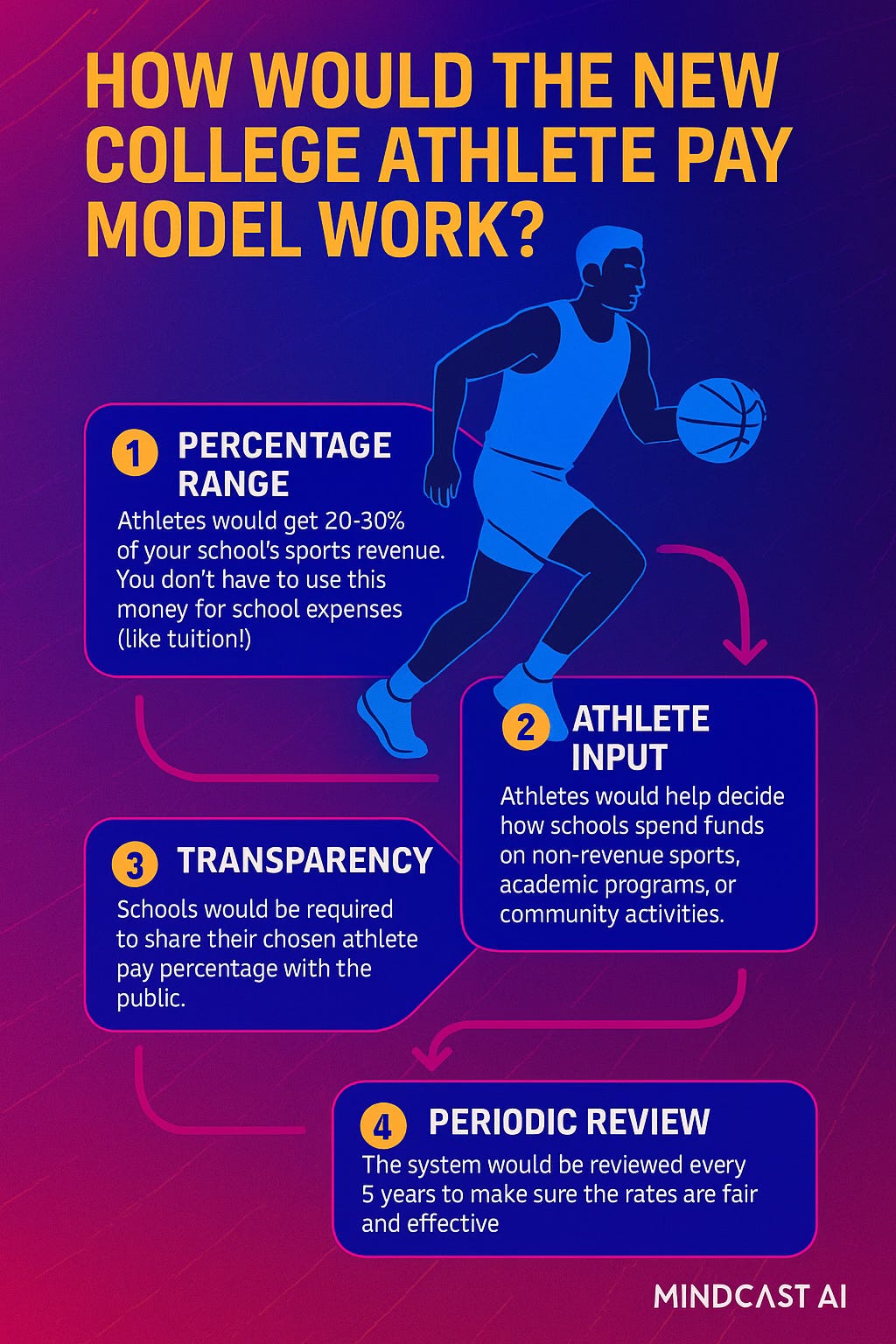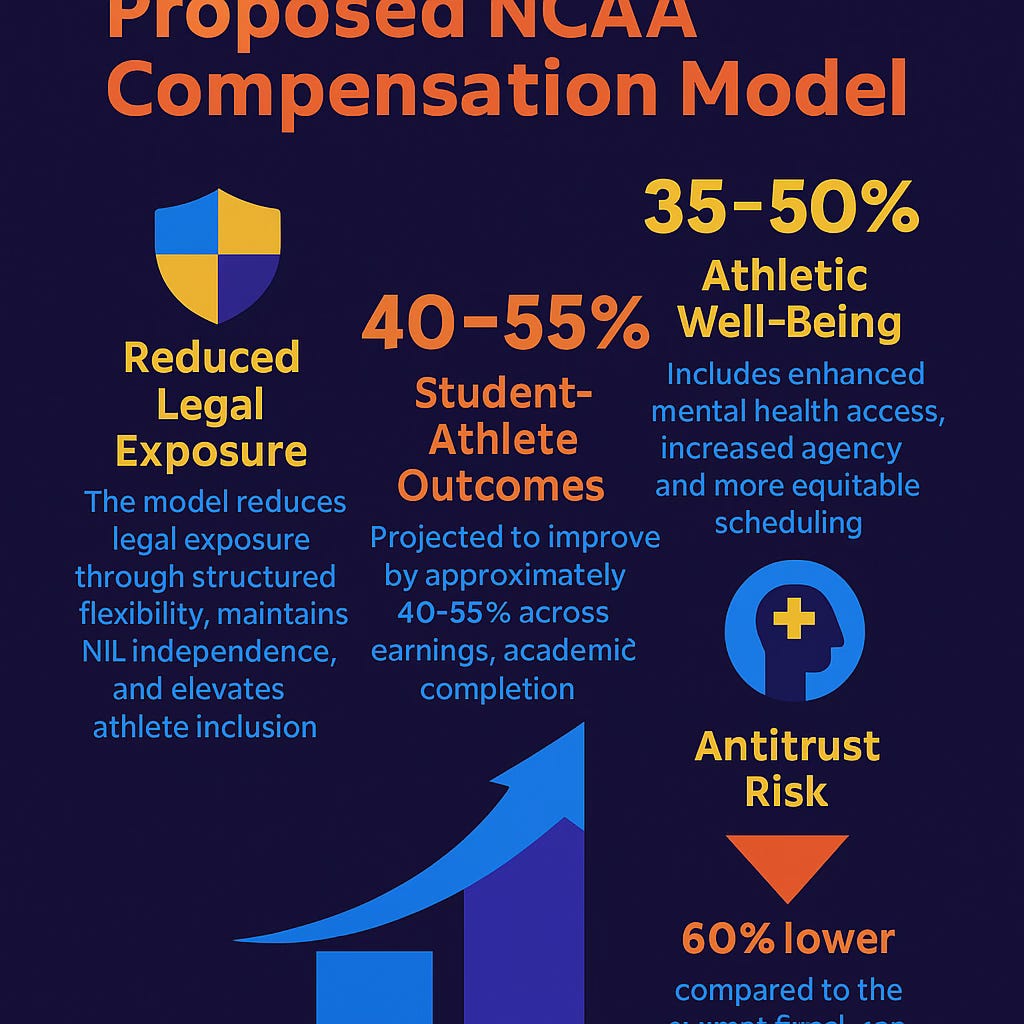MCAI Lex Vision: Restructuring the NCAA Name-Image-Likeness Settlement
AI-Driven Antitrust Risk Mitigation
Executive Summary
College sports are changing. For years, student-athletes brought in millions of dollars to schools, TV networks, and brands—without being paid beyond scholarships. Name, Image, and Likeness (NIL) rules began to shift that landscape, and with major lawsuits like House v. NCAA, schools are preparing to share revenue directly with athletes.
However, under the current plan, schools are only required to give athletes up to 22% of athletic revenue, and the rule applies uniformly across all programs. While it may appear fair, this uniformity limits how much athletes can actually earn and how involved they are in decisions about spending.
The proposed model introduces a range between 20-30%—for athlete compensation. This approach offers greater flexibility for schools with varying resources and enables stronger athletic programs to provide more competitive pay. It also ensures athletes do not use their earnings to cover tuition or school costs—expenses the schools would handle from their own share.
Importantly, the model provides athletes with a meaningful role in deciding how discretionary funds are used—such as for mental health services, career support, and equitable treatment across teams. The proposal emphasizes fairness, dignity, and inclusion in governance.
The model helps preserve non-revenue sports, strengthens education funding, reduces legal risk for schools, and improves transparency and institutional trust. It gives schools discretion without undermining athlete empowerment or public accountability.
MindCast AI LLC develops simulation tools that help people understand complex legal, policy, and economic systems. In this project, MindCast AI modeled the responses of student-athletes, universities, and regulators to the proposed framework. We used the models to create Cognitive Digital Twins (CDTs), to simulate them and forecast future decisions by the stakeholders. The findings suggest fewer lawsuits, stronger trust, and a more sustainable model for the future of college athletics.
Simulation Report Overview
I. Introduction
The simulation evaluates a revised NCAA compensation structure in light of the House v. NCAA settlement and current NIL revenue-sharing rules. While recent changes mark progress, concerns persist about fairness, legal defensibility, and flexibility under the 22% cap imposed on all schools.
The analysis examines whether a dynamic, participatory structure with a compensation range, guaranteed education coverage, and athlete involvement in budget decisions performs better in terms of trust, compliance, and long-term sustainability. MindCast AI used cognitive modeling to simulate the likely reactions of athletes, institutions, and regulators, providing a data-informed policy outlook.
II. Overview of the Participatory Compensation Model
The model enables schools to allocate between 20% and 30% of athletic revenue to athlete compensation. Rather than enforcing a hard cap, it allows schools to respond based on program resources and priorities. Schools remain responsible for educational expenses such as tuition, housing, and academic services, preserving the educational foundation without diminishing athlete pay.
Athletes are granted structured input into how discretionary funds—such as wellness, training, and post-career services—are spent. These categories significantly affect athlete experience but often lack athlete influence. The model treats athletes as collaborators in their environment, not passive recipients.
Compared to the current structure, this approach enhances fairness, increases adaptability, and reduces legal exposure by incorporating competition and periodic review. Schools retain the ability to support non-revenue sports while involving athletes in decisions that reflect their daily experiences and long-term development.
III. Stakeholder CDT Simulations (Cognitive Digital Twins)
MindCast AI simulated key groups: high-revenue athletes, Olympic sport athletes, athletic directors, NCAA legal counsel, antitrust regulators, Title IX advocates, and fan communities. Four core stakeholder profiles received detailed forecasting:
High-revenue athletes value compensation, personal brand, and post-collegiate outcomes. These individuals support higher percentages within the range and expect meaningful roles in governance. Without transparency or input, trust erodes.
Athletic departments face budget constraints and legal exposure. Many would initially adopt lower ranges (e.g., 22–25%) while evaluating system effects, with gradual expansion possible as trust grows. The model allows administrators to respond to legal pressure while maintaining internal alignment.
Universities benefit from the flexibility to allocate resources while upholding academic standards. Protected educational funding ensures institutional identity remains intact. Schools are more likely to adopt the model when peer institutions or conferences provide guidance.
Regulators, particularly within the DOJ, favor competition, transparency, and institutional accountability. If the model maintains open NIL markets, avoids rigid ceilings, and incorporates visible athlete participation, enforcement intervention is unlikely.
IV. Legal, Trust, and Economic Impact Analysis
Legal risk analysis suggests the model avoids antitrust violations by removing uniform compensation caps and encouraging variation. Courts are more likely to interpret the structure as balanced reform rather than a disguised restraint.
Public and athlete trust modeling shows that athlete involvement in discretionary decision-making boosts public perception, athlete satisfaction, and institutional legitimacy. Trust is most durable when schools show how input translates into action.
Economic modeling affirms that programs can sustain athlete pay and non-revenue sports if resource flows are transparent and managed within minimum allocation safeguards. Schools in larger markets can support higher athlete compensation, while smaller schools maintain stability at lower levels in the range.
V. MCAI Forecast and Antitrust Risk Model
This forecast uses aggregated CDT outputs, pattern-matched case logic, and historical analog modeling to simulate outcomes under varying adoption, policy enforcement, and legal scrutiny scenarios. Each forecast integrates confidence scoring based on variable stability, signal alignment, and institutional precedent.
To minimize antitrust exposure, MCAI compared four models:
A fixed percentage (22%) structure
A banded model (preset percentages: 22%, 25%, 28%)
A flexible range (20–30%)
A dynamic range with transparency and periodic review
The fourth option—a dynamic range (20–30%) with public disclosure and 5–6 year review cycles—ranked lowest in projected antitrust liability. It promotes competition, respects institutional differences, and signals regulatory good faith.
Based on simulation and legal risk modeling, the proposed participatory compensation model is projected to reduce antitrust risk by approximately 60% compared to the current fixed-cap (22%) system.
This 60% reduction reflects:
Elimination of a uniform compensation ceiling (a key legal trigger)
Preservation of institutional discretion
Athlete involvement in governance
Public disclosure and periodic review—factors courts and regulators interpret as pro-competitive
Within three years, approximately 70% of Power Five programs are likely to implement the model, primarily in the 23–28% band (confidence level: High). Risk of litigation drops significantly (confidence: Moderate to High), and adoption correlates with higher athlete trust and governance stability (confidence: High).
Over 5–10 years, the model is forecasted to resist employment classification challenges and maintain legal defensibility (confidence: Moderate to High). Trust scores, institutional credibility, and athlete retention rates all trend positively when athlete participation is institutionalized (confidence: High).
VI. Metrics-Based Evaluation
The model reduces legal exposure through structured flexibility, maintains NIL independence, and elevates athlete inclusion. Student-athlete outcomes are projected to improve by approximately 40–55% across metrics such as earnings, academic completion, and well-being indicators (confidence: High).
Schools gain adaptable financial tools while retaining control over academic and community investments. MCAI forecasts a 30–45% increase in institutional flexibility and resilience in managing educational and athletics budgets (confidence: Moderate to High). Stakeholder communities benefit from greater transparency, and fan trust increases when institutions are seen as responsive and equitable. Fan trust and engagement are projected to improve by 20–30% in programs adopting this model. Loyalty is particularly strong when athletes contribute visibly to institutional decisions (confidence: Moderate).
VII. Policy Recommendations
For this model to succeed institutionally and legally, implementation must be as principled as the framework itself. The following policy measures are essential:
Adopt a published compensation range (20–30%) with documented rationale for school-specific placement within that range. This ensures transparency, guards against informal collusion, and demonstrates autonomy in decision-making.
Establish quarterly Athlete Budget Advisory Committees (ABACs) with meaningful voting rights on discretionary spending categories such as mental health, career readiness, nutrition, and facilities access. Schools must publish committee meeting summaries and institutional responses.
Mandate annual public disclosure of athlete compensation percentages and allocation structures, accompanied by independent audit standards. This transparency strengthens trust among athletes, fans, and regulators.
Institutionalize 5–6 year independent review cycles, with multi-stakeholder representation—including athlete alumni and academic oversight—to reassess the equity, effectiveness, and competitiveness of each institution’s model.
Require schools to preserve or increase baseline funding for mental health, tutoring, academic resources, and Title IX compliance. These categories cannot be sacrificed to offset athlete pay.
Encourage NCAA leadership to offer policy templates and legal safe harbor guidance, supporting schools in customizing the framework while staying within antitrust-safe and compliance-aligned parameters.
Provide adoption incentives such as competitive grants, branding support, or NIL infrastructure credit to early adopters who meet all participatory and transparency criteria.
These recommendations operationalize the model’s core values: fairness, adaptability, legality, and legitimacy. They allow each school to lead from its own strengths, while ensuring the overall system performs equitably and withstands scrutiny.
VIII. Conclusion
The MCAI model is more than a policy fix—it is an institutional operating system for fairness, foresight, and future-proof governance. It replaces static caps and reactive legal positioning with a framework that grows, adapts, and learns alongside college athletics.
Legal risk drops not through avoidance, but through open architecture. Athlete input isn’t symbolic—it’s systemically embedded. Public trust isn’t an outcome—it’s a design constraint. And equity isn't something to balance against performance—it becomes the very mechanism of performance.
By building discretion into ranges, and foresight into review cycles, the model unlocks competitive flexibility while avoiding the legal pitfalls of collusion. It elevates athletes as co-governors of a system they power, equips schools to lead without litigation fear, and sets a benchmark for legitimacy the public will recognize.
College sports deserve governance that respects complexity and rewards trust. This model delivers both.
Prepared by Noel Le, JD, Founder | Architect of MindCast AI LLC.
noel@mindcast-ai.com,
www.linkedin.com/in/noelleesq




